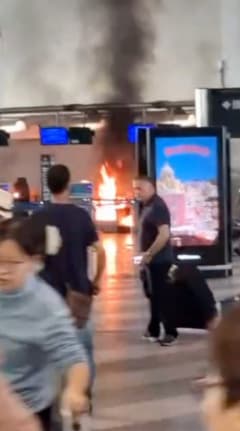From Airports to Social Media: How Incidents Go Viral
 The Tech Times
The Tech Times
In today's hyper-connected world, incidents at public places often transcend their immediate impact, evolving into global talking points. A recent event at Milan's airport is a perfect illustration of this phenomenon. A fire broke out at a check-in desk, and footage of the ensuing chaos, which included a man being knocked to the ground after smashing an advertisement screen, quickly went viral on social media.
Historically, incidents at airports have always garnered significant attention due to their potential implications on safety and security. However, the rapid dissemination of such events through social media is a relatively recent development. This change in dynamics has profound implications on public perception and the handling of such incidents.
The Changing Role of Social Media
In the past, news about incidents like the Milan airport fire would have been disseminated through traditional media outlets. The public would rely on newspapers, television, and radio for updates, often with a delay. However, the advent of smartphones and social media platforms like Twitter, Facebook, and Instagram has revolutionized this process. Now, ordinary citizens can act as real-time reporters, sharing raw footage and firsthand accounts directly from the scene.
This democratization of news has its benefits. It allows for a more immediate and diverse representation of events, often capturing aspects that traditional media might overlook. In the case of the Milan airport incident, the video footage shared by onlookers provided an unfiltered view of the chaos and confusion, resonating with viewers worldwide.
Historical Context: The Power of Viral Moments
The concept of viral content is not new, but its power has been amplified in the digital age. Historical events, such as the Rodney King beating in 1991, highlighted the impact of visual evidence in shaping public opinion. The grainy footage of King's assault by police officers was pivotal in sparking widespread outrage and discussion about police brutality.
Similarly, the 2003 Columbia Space Shuttle disaster demonstrated how quickly news could spread even before smartphones were ubiquitous. News outlets scrambled to cover the event, but it was live coverage and emerging online forums that kept the public engaged and informed.
Today, such events unfold even faster. The Milan airport footage is just one in a long line of viral moments that capture public attention and spark global conversations. This trend raises questions about the role and responsibility of individuals in sharing sensitive content.
Implications and Conclusions
The viral nature of such incidents poses unique challenges and opportunities. On one hand, it increases transparency, holding authorities accountable and compelling them to respond more swiftly and effectively. On the other hand, it can also lead to misinformation, as raw footage without context can be misleading.
For authorities and media organizations, the challenge lies in balancing the need for accurate, timely information with the potential for sensationalism. As incidents like the Milan airport fire continue to capture global attention, it is crucial for stakeholders to navigate this landscape thoughtfully.
In conclusion, the Milan airport incident underscores the transformative power of social media in shaping contemporary news narratives. As we continue to witness the evolution of how information is shared and consumed, it is imperative to remain vigilant about the accuracy and implications of the content we encounter. The digital age has expanded our access to information, but it also demands a more critical approach to the media we consume.
Subscribe to my newsletter
Read articles from The Tech Times directly inside your inbox. Subscribe to the newsletter, and don't miss out.
Written by
